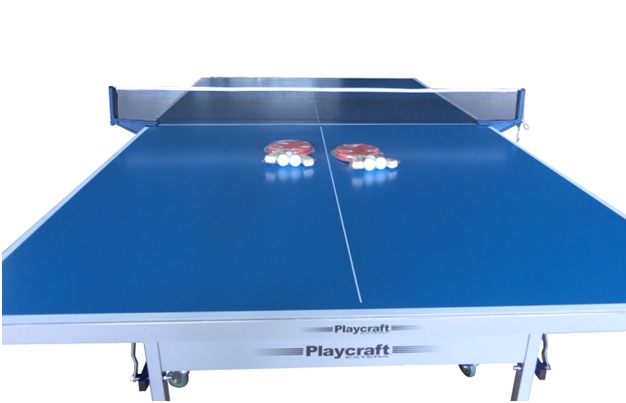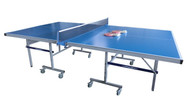How to Get Better at Ping Pong: a Guide For Beginners
Oct 6th 2023
Playing ping pong or table tennis requires a combination of strategy, speed, and finesse. Even if you’re a novice player, there are several steps you can take to improve your game.
Here's an in-depth look at how to get better at ping pong (and why you might want to consider investing in a high-quality outdoor ping-pong table!)
Learn the Basic Rules and Objectives
Before delving deeper, understand the game's basic rules and objectives. Familiarize yourself with scoring, serving, and the legal ways to strike the ball. Knowing these basic elements will help form a foundation upon which you can build your skills.
Ping Pong Equipment
Each player uses a paddle, covered with rubber on both sides, to play the game. The ball should be spherical, usually made of celluloid or similar plastics.
Starting the Game
A coin toss usually decides which player will serve first. The winner of the coin toss has the option to choose to serve, receive, or pick a side of the table.
Serving
- The serve must start with the ball resting freely on the flat palm of the server's stationary free hand.
- The server then tosses the ball straight up into the air, without imparting spin, and must strike it as it is falling.
- The ball must first bounce on the server’s side of the table before going over the net and bouncing on the opponent’s side.
- In doubles, the ball must touch the right half portion of the table on both the server's and receiver's side.
Scoring
- A player scores a point when the opponent fails to make a correct service, to return the ball, or returns the ball out of play.
- Each player serves for two points in a row and then the serve switches to the other player (or pair, in doubles).
- In a regular game, the first player to reach 11 points wins, but a player must win by at least two points.
Rally
- After the serve, players must return the ball before it bounces twice on their side of the table.
- The ball must pass over or around the net and hit the opponent’s side of the table for the rally to continue.
- A player loses the rally if they hit the ball into the net, off the table, or fail to hit it before it bounces twice on their side.
Match Structure
- A match typically consists of an odd number of games, usually best of 5, 7, or 9.
- Players switch sides of the table at the end of each game and when one player reaches 5 points in the final game of a match.
Doubles Play
- In doubles, each player on the team must hit the ball alternately.
- The service must be diagonal, from the right-hand half of one side to the right-hand half of the other side.
Timeouts and Breaks
Players are allowed to take a one-minute timeout during a match, and there are also breaks between games.

Deeper Ping Pong Mechanics
Master the Grip
The grip is crucial in controlling the paddle and, subsequently, the ball. There are several types of grips like the Shakehand Grip and the Penhold Grip, each offering different advantages. Practice different grips and find the one that feels the most comfortable and offers the best control.
Develop a Strong Stance and Footwork
Maintain a balanced and flexible stance, keeping your feet shoulder-width apart and your knees slightly bent. Strong footwork allows for quick and agile movements, enabling you to reach the ball efficiently. Practice side-to-side movements and work on improving your agility and speed.
Focus on Ball Control
Learn how to control the ball’s direction, spin, and speed. Start by practicing simple strokes and gradually move to more complex ones. Consistency is crucial; aim to hit the ball to the same spot repeatedly before trying different shots.
Understand Spin Mechanics
Different spins, like topspin, backspin, and sidespin, can significantly affect the ball’s trajectory and bounce. Learn how to impart spin on the ball and how to counteract the spin from your opponent's shots. Spin can be a decisive factor in winning points, so mastering it is essential.
Practice Different Strokes
Different situations call for different strokes, such as drives, loops, and chops. Start by perfecting the basic strokes before moving on to more advanced techniques like the smash and the block. Learning a variety of strokes will make your game more versatile and unpredictable.
Improve Your Serve
A powerful and deceptive serve can give you a significant advantage. Experiment with different serve techniques, spins, and placements to keep your opponent guessing. Varying your serves will make it more challenging for your opponent to predict and return your shots effectively.
Develop Tactical Awareness
Understanding strategies and tactics is essential in becoming a proficient player. Observe your opponent's playing style, identify their strengths and weaknesses, and adapt your game accordingly. Learn when to play aggressively and when to focus on defense, based on your opponent's actions.
Other Tips For Getting Better at Ping Pong
Play Regularly and Compete
The more you play, the better you become. Regular practice helps in honing your skills, improving your reflexes, and increasing your understanding of the game. Engage in competitive matches to experience various playing styles and to learn how to handle pressure.
Watch and Learn from Professionals
Watching professional players can provide insights into advanced techniques, strategies, and match play.
Observe their movements, shot selections, and tactics, and try to incorporate these elements into your game. You can find professional matches on sports channels or online platforms like YouTube.
Maintain Your Equipment
Regularly clean your paddle and replace the rubber when it starts to wear out. Using a well-maintained paddle ensures that you can play your best game and that your equipment doesn't hinder your performance.
Set Realistic Goals and Stay Positive
Identify areas you want to improve in and set achievable goals. Track your progress and celebrate small victories. Staying positive and motivated is crucial in overcoming challenges and improving your game.
Stay Fit and Healthy
Fitness is crucial in ping pong as it involves a lot of quick movements, reflexes, and endurance. Regular cardiovascular exercises, strength training, and flexibility exercises will help improve your fitness levels and reduce the risk of injury.
Seek Coaching
If possible, consider getting a coach. A coach can provide personalized advice, point out areas that need improvement, and help you develop a training regimen suited to your needs.
Analyze Your Games
After each game, reflect on your performance. Identify what you did well and what you could have done better. Analyzing your games helps in recognizing patterns, understanding mistakes, and improving strategies.
Practice on a High-Quality Ping Pong Table
Improving at ping pong requires a combination of skill development, regular practice, strategic understanding, and mental toughness. It also requires an actual ping-pong table!
Here at eFamilyFun, we have a variety of ping pong tables available, with a variety of different features and styles, including outdoor ping pong tables that are perfect for family gatherings and friendly tournaments. Even if you have enough room inside your house to support a full-fledged game room, with outdoor tables you gain the benefit of more freedom of movement. This is important especially when you are just starting out and are getting a feel for the game with friends and family.
We hope you’ve enjoyed this beginner’s guide to getting better at ping pong. By focusing on the fundamentals you can significantly enhance your game, as with any sport. Whether you aim to play competitively or just for fun, following these steps will help you become a more proficient ping pong player.

